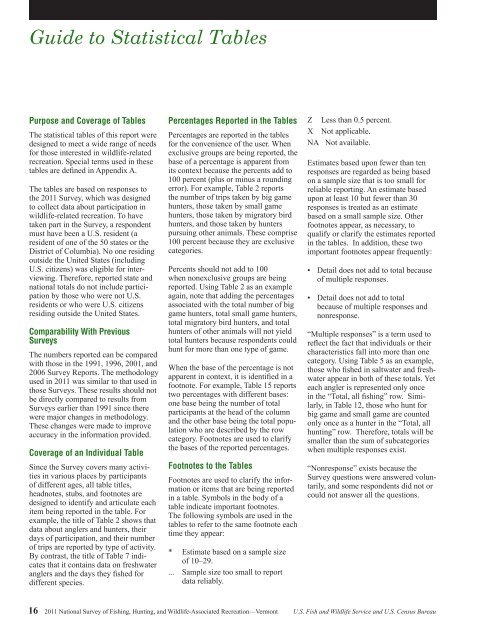2011 National Survey of Fishing, Hunting, and ... - Census Bureau
2011 National Survey of Fishing, Hunting, and ... - Census Bureau
2011 National Survey of Fishing, Hunting, and ... - Census Bureau
Create successful ePaper yourself
Turn your PDF publications into a flip-book with our unique Google optimized e-Paper software.
Guide to Statistical Tables<br />
Purpose <strong>and</strong> Coverage <strong>of</strong> Tables<br />
The statistical tables <strong>of</strong> this report were<br />
designed to meet a wide range <strong>of</strong> needs<br />
for those interested in wildlife-related<br />
recreation. Special terms used in these<br />
tables are defined in Appendix A.<br />
The tables are based on responses to<br />
the <strong>2011</strong> <strong>Survey</strong>, which was designed<br />
to collect data about participation in<br />
wi ldlife-related recreation. To have<br />
taken part in the <strong>Survey</strong>, a respondent<br />
must have been a U.S. resident (a<br />
resident <strong>of</strong> one <strong>of</strong> the 50 states or the<br />
District <strong>of</strong> Columbia). No one residing<br />
outside the United States (including<br />
U.S. citizens) was eligible for interviewing.<br />
Therefore, reported state <strong>and</strong><br />
national totals do not include participation<br />
by those who were not U.S.<br />
residents or who were U.S. citizens<br />
residing outside the United States.<br />
Comparability With Previous<br />
<strong>Survey</strong>s<br />
The numbers reported can be compared<br />
with those in the 1991, 1996, 2001, <strong>and</strong><br />
2006 <strong>Survey</strong> Reports. The methodology<br />
used in <strong>2011</strong> was similar to that used in<br />
those <strong>Survey</strong>s. These results should not<br />
be directly compared to results from<br />
<strong>Survey</strong>s earlier than 1991 since there<br />
were major changes in methodology.<br />
These changes were made to improve<br />
accuracy in the information provided.<br />
Coverage <strong>of</strong> an Individual Table<br />
Since the <strong>Survey</strong> covers many activities<br />
in various places by participants<br />
<strong>of</strong> different ages, all table titles,<br />
headnotes, stubs, <strong>and</strong> footnotes are<br />
designed to identify <strong>and</strong> articulate each<br />
item being reported in the table. For<br />
example, the title <strong>of</strong> Table 2 shows that<br />
data about anglers <strong>and</strong> hunters, their<br />
days <strong>of</strong> participation, <strong>and</strong> their number<br />
<strong>of</strong> trips are reported by type <strong>of</strong> activity.<br />
By contrast, the title <strong>of</strong> Table 7 indicates<br />
that it contains data on freshwater<br />
anglers <strong>and</strong> the days they fished for<br />
different species.<br />
Percentages Reported in the Tables<br />
Percentages are reported in the tables<br />
for the convenience <strong>of</strong> the user. When<br />
exclusive groups are being reported, the<br />
base <strong>of</strong> a percentage is apparent from<br />
its context because the percents add to<br />
100 percent (plus or minus a rounding<br />
error). For example, Table 2 reports<br />
the number <strong>of</strong> trips taken by big game<br />
hunters, those taken by small game<br />
hunters, those taken by migratory bird<br />
hunters, <strong>and</strong> those taken by hunters<br />
pursuing other animals. These comprise<br />
100 percent because they are exclusive<br />
categories.<br />
Percents should not add to 100<br />
when nonexclusive groups are being<br />
reported. Using Table 2 as an example<br />
again, note that adding the percentages<br />
associated with the total number <strong>of</strong> big<br />
game hunters, total small game hunters,<br />
total migratory bird hunters, <strong>and</strong> total<br />
hunters <strong>of</strong> other animals will not yield<br />
total hunters because respondents could<br />
hunt for more than one type <strong>of</strong> game.<br />
When the base <strong>of</strong> the percentage is not<br />
apparent in context, it is identified in a<br />
footnote. For example, Table 15 reports<br />
two percentages with different bases:<br />
one base being the number <strong>of</strong> total<br />
participants at the head <strong>of</strong> the column<br />
<strong>and</strong> the other base being the total population<br />
who are described by the row<br />
category. Footnotes are used to clarify<br />
the bases <strong>of</strong> the reported percentages.<br />
Footnotes to the Tables<br />
Footnotes are used to clarify the information<br />
or items that are being reported<br />
in a table. Symbols in the body <strong>of</strong> a<br />
table indicate important footnotes.<br />
The following symbols are used in the<br />
tables to refer to the same footnote each<br />
time they appear:<br />
* Estimate based on a sample size<br />
<strong>of</strong> 10–29.<br />
... Sample size too small to report<br />
data reliably.<br />
Z Less than 0.5 percent.<br />
X Not applicable.<br />
NA Not available.<br />
Estimates based upon fewer than ten<br />
responses are regarded as being based<br />
on a sample size that is too small for<br />
reliable reporting. An estimate based<br />
upon at least 10 but fewer than 30<br />
responses is treated as an estimate<br />
based on a small sample size. Other<br />
footnotes appear, as necessary, to<br />
qualify or clarify the estimates reported<br />
in the tables. In addition, these two<br />
important footnotes appear frequently:<br />
• Detail does not add to total because<br />
<strong>of</strong> multiple responses.<br />
• Detail does not add to total<br />
because <strong>of</strong> multiple responses <strong>and</strong><br />
no nresponse.<br />
“Multiple responses” is a term used to<br />
reflect the fact that individuals or their<br />
characteristics fall into more than one<br />
category. Using Table 5 as an example,<br />
those who fished in saltwater <strong>and</strong> freshwater<br />
appear in both <strong>of</strong> these totals. Yet<br />
each angler is represented only once<br />
in the “Total, all fishing” row. Similarly,<br />
in Table 12, those who hunt for<br />
big game <strong>and</strong> small game are counted<br />
only once as a hunter in the “Total, all<br />
hunting” row. Therefore, totals will be<br />
smaller than the sum <strong>of</strong> subcategories<br />
when multiple responses exist.<br />
“Nonresponse” exists because the<br />
<strong>Survey</strong> questions were answered voluntarily,<br />
<strong>and</strong> some respondents did not or<br />
could not answer all the questions.<br />
16 <strong>2011</strong> <strong>National</strong> <strong>Survey</strong> <strong>of</strong> <strong>Fishing</strong>, <strong>Hunting</strong>, <strong>and</strong> Wildlife-Associated Recreation—Vermont U.S. Fish <strong>and</strong> Wildlife Service <strong>and</strong> U.S. <strong>Census</strong> <strong>Bureau</strong>
















